Recipe
Let me tell you, this bread pudding is a game-changer—seriously, it’s the kind of dessert that will have your family begging for seconds. What makes it so special? It’s all about that perfect balance of creamy custard and golden, crispy edges, soaked into cubes of day-old bread that transform into pure magic in the oven.
I’ve been making this recipe for years, and it’s foolproof—whether you’re a baking pro or a total beginner, you’ll nail it. The secret? A splash of vanilla and a hint of cinnamon that fills your kitchen with the most comforting aroma.
Imagine digging into a warm, indulgent bite that’s soft, slightly gooey, and just sweet enough to hit the spot. Trust me, once you try this, it’s going straight into your dessert rotation. Let’s get baking!
Ingredients
Bread pudding is all about texture and balance—stale bread soaks up the custard without turning mushy, while the right mix of dairy and eggs creates that perfect creamy-yet-firm bite. Here’s what you’ll need, with a few chef-approved tweaks to make it your own:
- Stale bread (6 cups, cubed): Day-old French bread or brioche works best—their tight crumb holds up. Avoid super-soft sandwich bread (it turns soggy). No stale bread? Toast fresh cubes at 300°F for 10 minutes to dry them out.
- Whole milk (2 cups): The fat content is key for richness. In a pinch, sub half-and-half or even coconut milk for a dairy-free twist.
- Heavy cream (1 cup): Non-negotiable for that luscious custard. Don’t skimp!
- Eggs (4 large): They bind everything—fresh eggs whip up fluffier.
- Sugar (¾ cup): Granulated for the base, but brown sugar adds a caramel depth if you’re feeling fancy.
- Vanilla extract (2 tsp): Pure vanilla is worth it here—imitation tastes flat.
- Cinnamon (1 tsp): Warm and essential. Freshly ground beats pre-ground any day.
- Salt (½ tsp): Balances the sweetness. Sea salt or kosher, not table salt.
- Raisins or dried cranberries (½ cup, optional): Soak them in warm water or rum for 10 minutes first to plump up.
- Butter (2 tbsp, melted): Brushed on top for a golden crust. Salted butter adds a nice contrast.
Pro tip: Toss in a pinch of nutmeg or cardamom for extra warmth, or fold in chocolate chips if you’re skipping the fruit. For a showstopper finish, drizzle with bourbon caramel sauce right before serving.
How to Make the Best Classic Bread Pudding Technique

– Preheat your oven to 350°F (175°C), guaranteeing it’s ready when your mixture is prepared. A properly preheated oven guarantees even baking and prevents undercooking.
For best results, use an oven thermometer to verify the temperature.
– Butter a 9×13-inch baking dish generously to prevent sticking. Use softened butter and spread it evenly across the bottom and sides of the dish.
This also adds a subtle richness to the pudding’s crust.
– Whisk together eggs, milk, cream, sugar, and vanilla extract in a large bowl until smooth. Take care not to overmix—just combine until the ingredients are incorporated.
Overwhipping can introduce too much air, leading to a less custardy texture.
– Add cinnamon and nutmeg to the mixture for warmth and depth of flavor. These spices complement the bread and custard beautifully.
Use freshly grated nutmeg if possible for a brighter, more aromatic taste.
– Tear stale bread into bite-sized pieces and place them in the prepared baking dish. Stale bread absorbs the custard better than fresh bread, creating a soft yet structured texture.
If your bread isn’t stale, toast it lightly for a similar effect.
– Pour the custard mixture evenly over the bread, guaranteeing all pieces are soaked. Let it sit for 10-15 minutes to allow the bread to fully absorb the liquid.
This step is vital for a creamy, cohesive pudding.
– Press down gently on the bread with a spatula to submerge any floating pieces. This guarantees every bite is evenly custardy and prevents dry spots.
Avoid pressing too hard, which can compact the pudding.
– Bake for 45-50 minutes, or until the top is golden brown and the center is set. To test, insert a knife into the center—it should come out clean with just a slight custard sheen.
Overbaking can dry out the pudding, so keep an eye on it.
– Let it cool for 10 minutes before serving. This allows the custard to set further and makes it easier to slice.
Serve warm with a drizzle of caramel sauce or a dusting of powdered sugar for added indulgence.
– Store leftovers covered in the fridge for up to 3 days. Reheat gently in the oven or microwave to restore its soft, custardy texture.
Bread pudding often tastes even better the next day as the flavors meld!
Nutrition
This homemade bread pudding is a comforting dessert with a rich nutritional profile. Below is the breakdown per serving.
| Nutrient | Amount per Serving |
|---|---|
| Calories | 350 kcal |
| Fat | 15 g |
| Carbohydrates | 45 g |
| Protein | 8 g |
| Sugar | 25 g |
| Fiber | 2 g |
| Sodium | 300 mg |
Chef Tips
Mastery in making bread pudding lies in the balance of texture and flavor. I always use slightly stale bread—it absorbs the custard better without turning mushy.
Don’t overmix the custard; a gentle hand keeps it light. I bake it in a water bath for even cooking and prevent cracking.
Let it rest before serving to set the flavors. A hint of vanilla or rum elevates it perfectly.
Frequently Asked Questions
Can I Freeze Bread Pudding for Later?
Yes, I can freeze bread pudding for later. I let it cool completely, then wrap it tightly in plastic wrap or aluminum foil. It’ll keep for about 2-3 months. I reheat it in the oven when I’m ready to enjoy it.
What’s the Best Type of Bread to Use?
I’d use a stale, slightly dense bread like brioche, challah, or French bread—it soaks up the custard without falling apart. I avoid soft sandwich bread because it gets too mushy and lacks texture.
How Long Does Bread Pudding Stay Fresh?
I’d say bread pudding stays fresh for about 3-4 days if you store it in the fridge. Just cover it tightly so it doesn’t dry out. You can also freeze it for up to a month.
Can I Make Bread Pudding Without Eggs?
Yes, I can make bread pudding without eggs—it’s totally doable. I’d use substitutes like mashed bananas, Greek yogurt, or cornstarch mixed with milk. It won’t bind the same, but it’ll still taste delicious.
Is Bread Pudding Gluten-Free?
I can’t say bread pudding’s gluten-free unless I use gluten-free bread. Traditional recipes call for regular bread, which contains gluten. If I swap it out, I’ll need to adjust other ingredients to keep the texture right.










